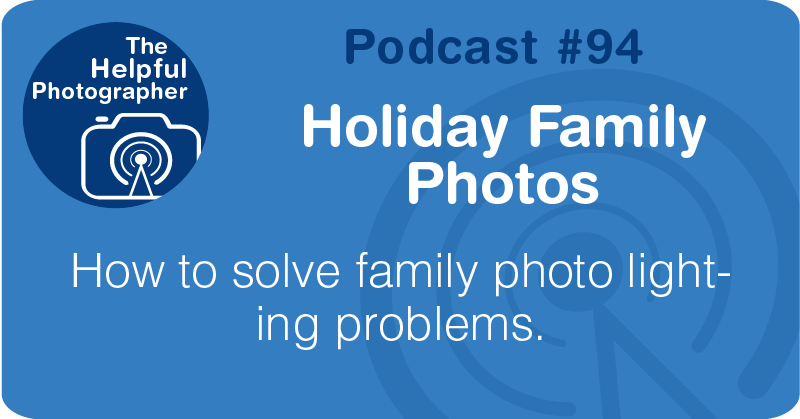Holiday Family Photos #94
Holiday Family Photos #94

Well it's that time of year again. Depending on your disposition it's either the dreaded or the happy holidays. But whether or not you are a fan of the holidays you have to admit it can be really fun to shoot. You have the family get together and all the lights and if you live in cold climates, the lights with the snow? That’s a pretty cool thing too. In this podcast I’ll address the family photo problems, because it’s the hard one. This usually presents a challenge for people because you're indoors and there's never enough light available. As a result people will reach for that nice fast 50mm lens but the problem is usually space because you are in a living room or dining room and you just can't get back far enough and if you want to include a Christmas tree well that's gonna be tough. And all of this is further compounded if you are using a cropped sensor camera, which let’s face it, most of you are and then you combine it with the 50mm which makes the scene really tight. The inclination to shoot with a prime lens is because they are capable of gathering more light and these family gatherings usually happen indoors after sunset…In other words you are shooting in a cave. So if this is what you have? Try to use something wider like 24 to 35mm prime on a full frame or somewhere between 18 and 24mm if you are shooting cropped sensor, and make sure you turn on all the lights you have available. But frankly, even with a really fast prime lens and all the lights on, very often it’s just not enough light so you’ll need to bring in flash. Yup, I said flash. I know most people will tell you not to use it. But that’s because they don’t know how to use it.
The great part about flash is it gives you a ton of light. The problem is it’s a very harsh light. Flash units are what we call a point source light and they tend to make everything look kinda nasty looking. You can fix this problem by diffusing the light. This gets a bit tricky when you talk about the little built in pop up flash. Although, there are a number of inexpensive diffusers you can now buy on line for less than $10 that seem to do the job reasonably well. I just bought several of these and hopefully I’ll be able to run a test and report back in a couple of months.
The preferred way to add light to your scene is to use a studio system but that’s very impractical for most people so I’m not even going down that road. Another option is the external speed light that attaches to your hot shoe. These are great as they provide a ton of light and very often they have articulating heads which allow you to point the light in different directions. This is really important because it allows you to bounce light off of walls and ceilings, and in doing so the entire wall becomes your light source and it is highly diffused. Many photographers will point the light directly up into the ceiling but this is usually a mistake. Although the big surface of the ceiling will produce a very very diffused the light, it is now raking downwards and leaving dark circles under people’s eyes. The better way would be to point the flash at an angle above your head and behind you. So that it is bouncing off the corner where the ceiling and the wall meets. This will help soften the light without the dark circles under people’s eyes.
You do want to be careful though, if you have walls that are painted anything other than white or off white, like red or maybe green or even yellow, the light bouncing back will have that color as well. So hopefully your room will be white, gray or even off white in color. So not only do you need to predict the angle of the light coming back you also need to predict the color. A better option is probably to buy a device that will sit right on top of your flash to diffuse the light. I’ve used many many of these over the years and I’ve come to find that the best ones look like a round plastic soup cup that sits on top of your flash unit. I won’t mention any specific brands as they pretty much all work the same. The question comes down to price and weight. There are also small white square plastic box looking things, they are cheap and they only work ok. Then there are the things that look like a studio soft box. These work reasonably well but not nearly as well as the roundish bulbish looking ones. Again there are multiple manufacturers out there. Just need to look around. All you need to do with these is to attach them to the top of your flash, point your flash upwards and blam! A beautiful soft light. Next week I’ll talk about shooting holiday lights.











